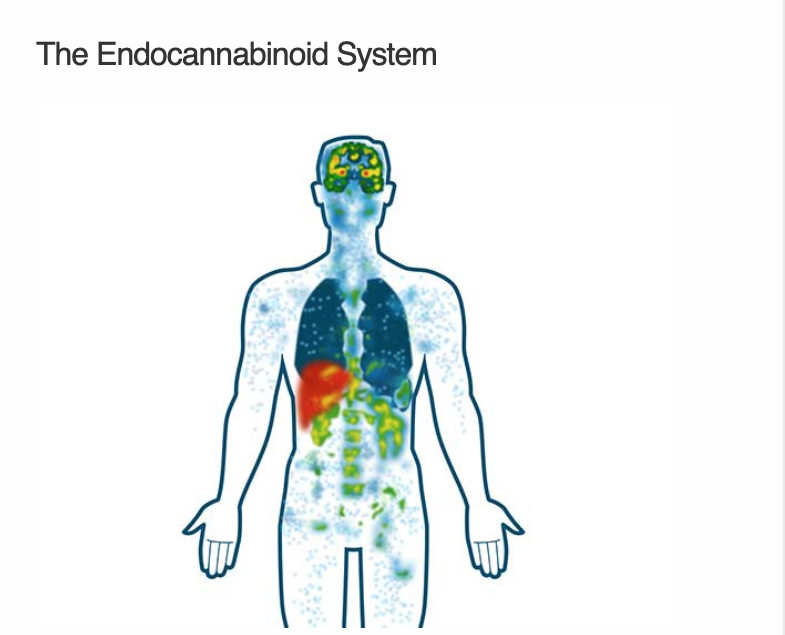The potential therapeutic effects of cannabis, or more specifically CBD is a result of it’s most active constituents, cannabinoids. Cannabis overall has a profound influence on the human body, and seems to affect every aspect of our bodies and minds. How is this possible?
Scientists discovered a previously unknown physiologic system, a central component of the health and healing of every human and almost every animal, the endocannabinoid system or ECS (endogenous cannabinoid system).
The endocannabinoid system has three basic components: endocannabinoids, cannabinoid receptors, and hydrolytic enzymes that break down endocannabinoids. Endocannabinoids are molecules produced by cells have are active similar to THC and the other phytocannabinoids (plant-derived cannabinoids). They are synthesized on the cell membrane from omega-6 fatty acid precursors. Both endo- and phytocannabinoids act on cannabinoid receptors, known as CB1 and CB2, found throughout the body. Stimulating the CB receptors leads to a variety of physiologic processes inside the cell. Finally, enzymes responsible for the breakdown and recycling of endocannabinoids, MAGL and FAAH, modulate the activity of the ECS.
The endocannabinoid system is perhaps the most important physiologic system involved in establishing and maintaining human health. Endocannabinoids and their receptors are found throughout the body: in the brain, organs, connective tissues, glands, and immune cells. In each tissue, the cannabinoid system performs different tasks, but the goal is always the same: homeostasis, the maintenance of a stable internal environment despite fluctuations in the external environment. Cannabinoids promote homeostasis at every level of biological life, from the sub-cellular to the organism, and perhaps to the community and beyond.
Endocannabinoids are found at the intersection of the body’s various systems, allowing communication and coordination between different cell types. At the site of an injury, for example, cannabinoids can be found decreasing the release of activators and sensitizers from the injured tissue, stabilizing the nerve cell to prevent excessive firing, and calming nearby immune cells to prevent the release of pro-inflammatory substances. Three different mechanisms of action on three different cell types for a single purpose: minimize the pain and damage caused by the injury.
The endocannabinoid system, with its complex actions in our immune system, nervous system, and all of the body’s organs, is literally a bridge between body and mind. By understanding this system we begin to see a mechanism that explains how states of consciousness can promote health or disease.
In addition to regulating our internal and cellular homeostasis, cannabinoids can influence a person’s relationship with the external environment. Socially, the administration of cannabinoids (especially THC) can alter human behavior, often promoting sharing, humor, and creativity. By mediating neurogenesis (the growth of new brain cells), neuronal plasticity (forming new connections between brain cells), and learning, cannabinoids may directly influence a person’s open-mindedness and ability to move beyond limiting patterns of thought and behavior from past situations. Reformatting these old patterns is an essential part of health in our quickly changing environment.
As scientists continue to sort through the emerging science of cannabis and cannabinoids, one thing remains clear: a functional cannabinoid system is essential for health. From embryonic implantation on the wall of our mother’s uterus to nursing and growth to responding to injuries, endocannabinoids help us survive in a quickly changing and increasingly hostile environment.
A body of evidence is now emerging that links endocannabinoid deficiency to a variety of diseases, including migraine, fibromyalgia, irritable bowel syndrome, and even infant colic. The market promises to deliver solutions as we learn more. It does appear if an individual enhances his/her cannabinoid system by taking supplemental CBD is effective treating symptoms, and beyond that, can help us prevent disease and promote health by stimulating an ancient system that is hard-wired into all of us.
Research has shown that small doses of cannabinoids from CBD can signal the body to make more endocannabinoids and build more cannabinoid receptors. This may be why many first-time CBD users don’t feel an effect, but by their second or third time using they have increased cannabinoid sensitivity and are ready to respond. More receptors increase a person’s sensitivity to cannabinoids; smaller doses have larger effects, and the individual has an enhanced baseline of endocannabinoid activity. Experts believe that small, regular doses of cannabis might act as a tonic to our most central physiologic healing system.

